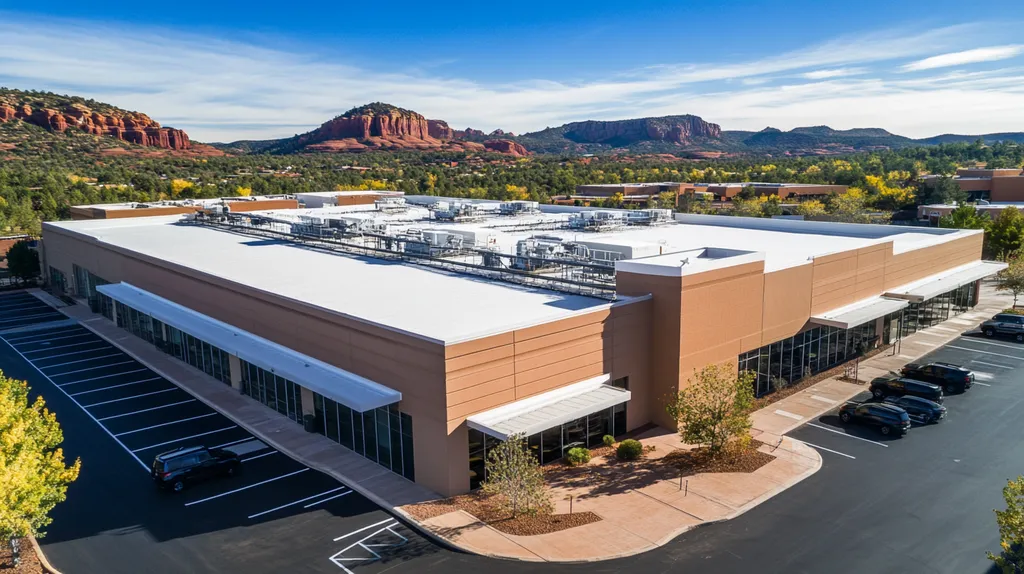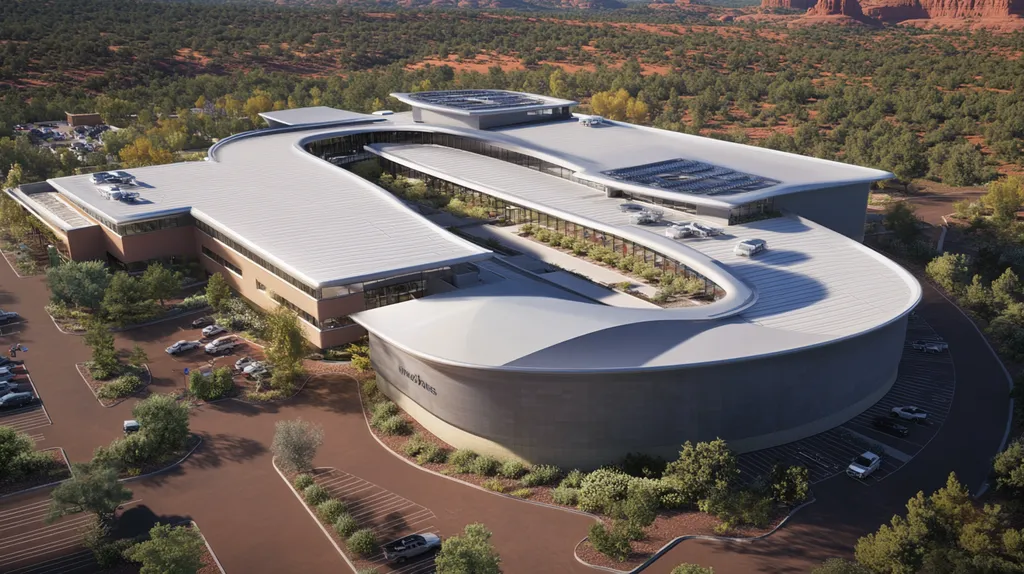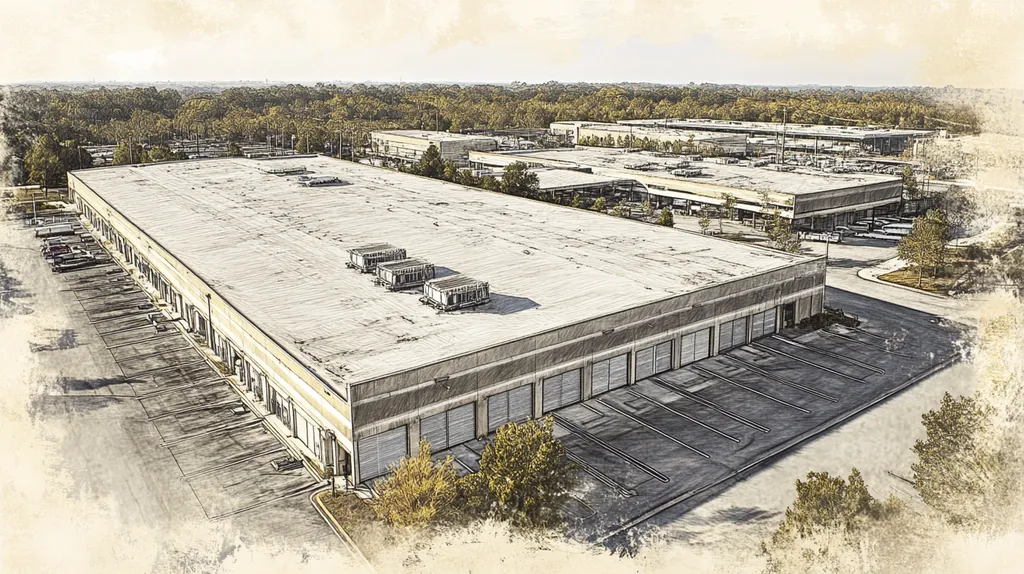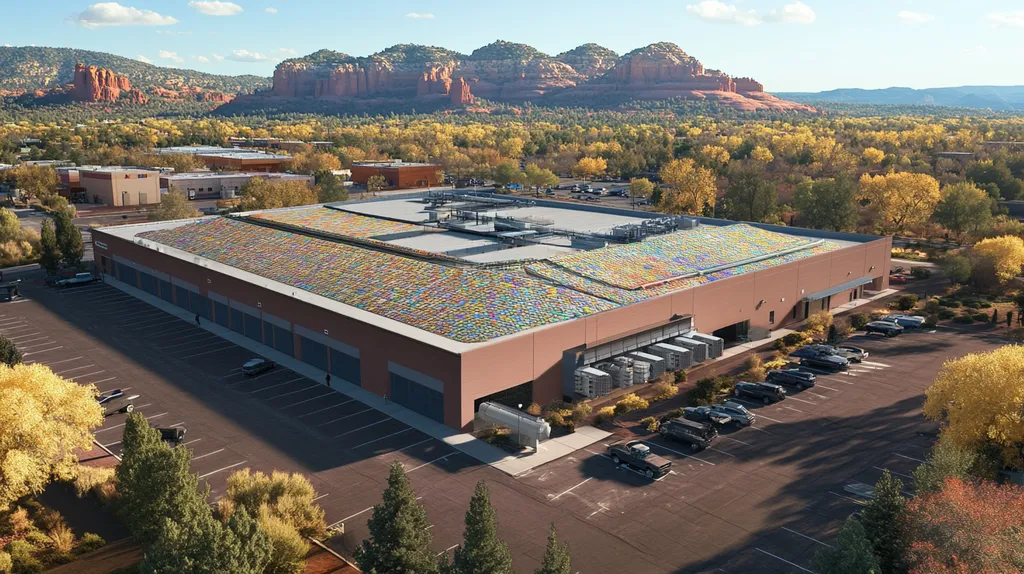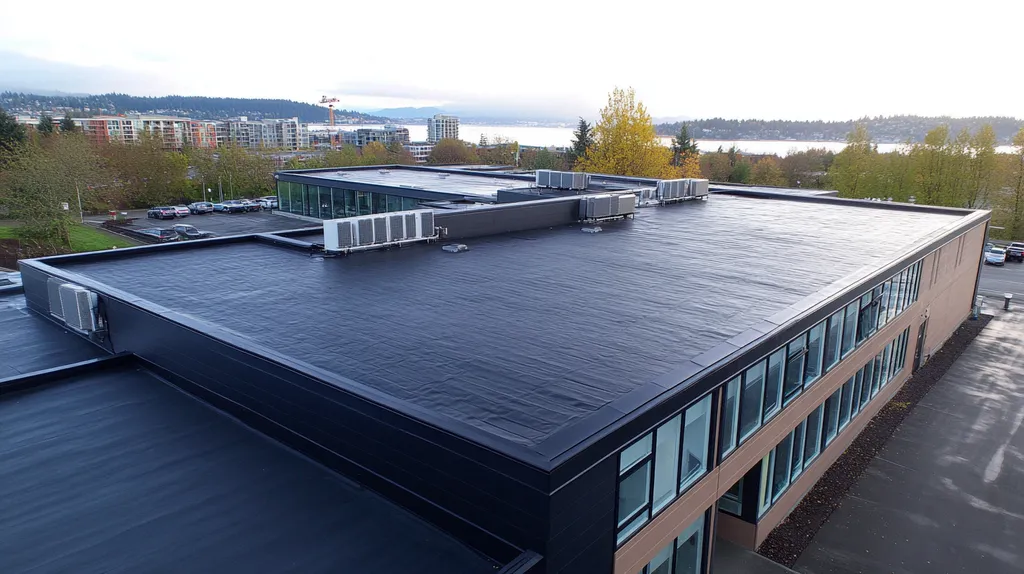Industrial roofs fail at an alarming rate—not from catastrophic storms, but from daily weather assault that destroys unprotected surfaces within a decade.
A pharmaceutical plant in Arizona recently faced $2 million in equipment losses when their “premium” roof coating peeled away like cheap paint, flooding critical production areas during monsoon season.
Every year, facility managers watch repair budgets spiral as UV radiation, thermal cycling, and water infiltration systematically destroy roofing materials that should last 20+ years.
The difference between roofs that survive decades versus those requiring replacement every 10-12 years often comes down to understanding coating chemistry, proper application, and avoiding the marketing myths that cost facilities millions in premature failures.
SECTION 1: THE BASICS EXPLAINED
Industrial roofs take a beating that would make a prizefighter wince. Relentless UV radiation, torrential downpours, hail storms, and temperature swings that can span 100+ degrees annually all conspire to crack, split, and degrade even the toughest roofing materials.
Without proper protection, facility managers watch helplessly as repair costs spiral upward and unexpected leaks shut down operations. The difference between a roof that lasts 15 years versus 30 years often comes down to one critical factor: coatings.
Understanding what roof coatings actually do—and cutting through the marketing fluff—can save your facility hundreds of thousands in premature replacement costs.
What It Is (In Plain Language)
Roof coatings are liquid-applied protective layers that cure into a seamless membrane over your existing roof. Think of them as industrial-strength sunscreen mixed with waterproof armor—but for buildings instead of beach vacations.
The three main types are acrylic (budget-friendly but requires more maintenance), silicone (excellent for ponding water), and polyurethane (the tank of roof coatings). Each has specific strengths, but all share the same basic job: keeping weather out and your roof intact.
Unlike those “revolutionary” roofing technologies that promise to change everything, coatings are refreshingly straightforward. They fill hairline cracks, seal pinholes, and create a continuous barrier that flexes with your building’s movement.
The beauty lies in their simplicity—no tear-off required, minimal disruption to operations, and significantly lower costs than full roof replacement. It’s protection that actually makes financial sense.
Why It Matters (To Your Building)
Water intrusion doesn’t just damage roofs—it destroys everything underneath. Manufacturing equipment, inventory, electrical systems, and structural steel all become expensive casualties when roofs fail unexpectedly.
A single leak in a pharmaceutical facility can contaminate entire production runs worth millions. Warehouses lose inventory to mold and water damage that spreads far beyond the initial breach point.
Coatings extend roof life by 10-15 years on average, turning a 20-year roof into a 30-35 year asset. That’s not marketing hyperbole—it’s documented performance from facilities that chose proactive protection over reactive crisis management.
The energy savings are equally compelling. Reflective coatings can reduce roof surface temperatures by 50-80 degrees, directly cutting cooling costs in large facilities where HVAC represents 40% or more of operating expenses.
Smart facility managers treat coatings as insurance policies that pay dividends instead of just collecting premiums. The math is simple: spend thousands now to avoid spending hundreds of thousands later.
How It Works
Coatings function by forming an elastic membrane that moves with your roof through thermal expansion and contraction. Unlike rigid materials that crack under stress, quality coatings stretch up to 300% without breaking.
Elastomeric coatings withstand UV rays, rain, and hail while maintaining flexibility under weather stress. Polyurethane roof coatings form seamless, durable layers that prevent leaks and damage through superior adhesion and chemical resistance.
The application process involves thorough cleaning, minor repairs, and then spraying or rolling the coating in specified thicknesses. Professional installation ensures optimal bonding and performance—this isn’t a DIY weekend project.
Once cured, the coating creates a monolithic surface that sheds water while reflecting heat. The membrane effectively resets your roof’s aging clock without the weight, cost, or disruption of traditional re-roofing methods.
Most coatings cure within hours but reach full strength over several days, during which they bond chemically with the substrate to create a integrated protective system (source: Renova Roofing).
SECTION 2: PRACTICAL APPLICATIONS
Industrial facilities burn through roofing budgets at an alarming rate—primarily because they treat symptoms instead of causes. A manufacturing plant in Phoenix might replace its metal roof every 12 years, while an identical facility with proper coatings pushes that timeline to 25+ years.
The difference isn’t luck or better weather. It’s understanding exactly when, where, and how coatings deliver maximum protection against the relentless assault of industrial-grade weather exposure.
Common Uses & Examples
Metal roofs on warehouses and manufacturing plants represent coating applications at their most dramatic. Reflective coatings can drop surface temperatures from 170°F to under 120°F, immediately cutting cooling costs by 15-25% in facilities where air conditioning fights a losing battle against superheated roof decks.
Flat membrane roofs get different treatment but equally impressive results. Elastomeric coatings seal the hairline cracks and pinhole leaks that turn minor maintenance into major emergencies when the next storm hits.
Chemical processing facilities rely on specialized coatings that resist acid rain and industrial emissions—environmental hazards that would dissolve standard roofing materials faster than a chemistry experiment gone wrong. Food processing plants use coatings to meet hygiene standards while handling temperature extremes from refrigerated storage areas.
The pattern holds across industries: facilities that coat proactively operate longer between major roof interventions. Those that wait for crisis mode spend 3-5 times more on emergency repairs and replacement cycles.
When You Need It Most
Timing separates smart facility managers from those constantly fighting roofing fires. The sweet spot hits when roofs show early weathering—surface chalking on metal, minor membrane shrinkage, or the first signs of UV degradation—but before structural damage occurs.
Coastal facilities face accelerated timelines due to salt air corrosion. Desert locations battle extreme temperature cycling that cracks even premium materials within 7-10 years without coating protection.
Silicone coatings withstand long-term ponding water exposure where other coatings fail completely, making them essential for low-slope roofs with drainage challenges. These coatings resist oxidation and provide excellent UV protection in extreme temperatures and harsh environments (source: FacilitiesNet).
Post-repair application creates the most cost-effective protection window. Applying coatings immediately after addressing leaks or replacing sections prevents the repair-failure cycle that plagues reactive maintenance programs.
Interactions With Other Systems
Coatings aren’t solo performers—they’re part of integrated roof systems that either work together or fail spectacularly. Reflective coatings amplify insulation performance by reducing heat transfer, but only when proper vapor barriers prevent moisture infiltration from below.
Drainage systems make or break coating longevity. Standing water undermines even premium coatings, turning expensive protection into expensive failure within 2-3 years.
HVAC units, skylights, and penetrations require compatible sealants and flashings. Mixing coating chemistries with incompatible materials creates weak points where water intrusion concentrates, defeating the entire protective strategy.
Maintenance scheduling must account for coating inspection cycles—typically every 2-3 years for touch-ups versus 15-20 years for complete reapplication. Facilities that integrate these timelines with other roof system maintenance reduce costs and extend overall performance significantly.
SECTION 3: KEY TERMINOLOGY DECODED
Coating salespeople love throwing around technical terms that sound impressive but mean nothing to facility managers making real decisions. This linguistic smoke screen costs facilities millions annually when specifications get misunderstood and inferior products slip through procurement.
The difference between “sounds good in a presentation” and “actually protects your roof” lies in understanding what these terms really mean—and which ones are just marketing fluff dressed up as science.
Essential Terms Explained
Elastomeric isn’t just a fancy word—it describes a coating’s ability to stretch up to 300% without cracking, then snap back to original form. This flexibility keeps your roof sealed when thermal cycling tries to tear ordinary materials apart.
Reflectivity gets measured as Solar Reflectance Index (SRI), where higher numbers mean cooler roofs and lower energy bills. Anything below 70 SRI is basically expensive paint that won’t deliver meaningful cooling benefits in industrial applications.
Permeability determines whether your coating breathes or blocks moisture completely. Low-perm coatings trap water vapor underneath, creating blisters and adhesion failures that contractors love to blame on “substrate issues.”
Adhesion strength gets tested in pounds per square inch, but the real test happens during the first windstorm. Quality coatings bond chemically with substrates instead of just sitting on top like expensive wallpaper.
Industry Jargon Translated
Base coat and topcoat aren’t interchangeable terms that salespeople can mix and match. Base coats provide waterproofing and substrate bonding, while topcoats handle UV protection and aesthetic appeal—each has distinct chemistry and performance requirements.
Mil thickness sounds technical but simply means thousandths of an inch. Most coating failures trace back to under-application because contractors pocket savings by skimping on material—10 mils applied instead of specified 20 mils cuts performance in half.
Cure time versus dry time creates expensive confusion during installation scheduling. Dry-to-touch happens in hours, but full chemical cure takes days or weeks depending on temperature and humidity conditions.
Silicone and Polyvinylidene Fluoride (PVDF) paint systems deliver superior weathering resistance compared to basic polyester coatings that cost less upfront but fail faster. PVDF coatings provide excellent resistance from metal weathering over time, with superior service life and color retention (source: Metalcon).
Measurement & Units Simplified
Dry Film Thickness (DFT) represents the actual protective barrier after solvents evaporate. Measuring DFT during application prevents the “oops, we’re short on material” conversations that lead to thin spots and premature failures.
Elongation percentages tell you how much stretch a coating can handle before breaking. Industrial roofs need minimum 300% elongation to survive thermal movement without developing stress cracks at seams and penetrations.
Tensile strength measures pulling force resistance, typically 200+ PSI for quality elastomeric coatings. Lower numbers indicate fillers and cheap resins that won’t survive wind uplift or thermal stress in real-world conditions.
Service life warranties range from 10 to 20 years depending on coating chemistry and application thickness. The fine print matters more than the headline numbers—pro-rated coverage and exclusions can make impressive warranties worthless when problems develop.
SECTION 4: DECISION FACTORS
Coating selection separates facilities that operate smoothly for decades from those caught in endless repair cycles. A single wrong choice can turn a $50,000 coating project into a $500,000 emergency roof replacement within five years.
The difference isn’t luck—it’s understanding how cost, performance, and durability interact in real-world industrial environments. Facilities that nail these decisions extend roof life by 15+ years while slashing unexpected maintenance costs.
Cost Considerations
Procurement departments love coating bids that look cheap on paper—until those “budget-friendly” solutions start peeling off in sheets during the first major storm. Real coating costs include material, labor, downtime, and the hidden expense of reapplication frequency that vendors conveniently forget to mention.
Premium coatings cost 40-60% more upfront but deliver 2-3 times the service life of bargain alternatives. A $3 per square foot polyurethane coating that lasts 20 years beats a $1.50 acrylic coating requiring reapplication every 7 years—basic math that somehow gets lost in budget meetings.
Labor costs multiply when coatings require extensive surface preparation or multiple application passes. Fast-curing formulations minimize operational disruption, saving thousands in lost productivity for facilities that can’t afford extended shutdowns.
Smart facilities calculate total cost of ownership over 20-year cycles instead of fixating on purchase orders. The cheapest coating per gallon often becomes the most expensive coating per year of actual protection delivered.
Performance Trade-offs
Every coating chemistry excels at something while sacrificing performance elsewhere—there’s no magical solution that masters every challenge. Silicone coatings dominate UV resistance and ponding water tolerance but create maintenance headaches because nothing sticks to them later, including future coating applications.
Polyurethane coatings provide good abrasion resistance and mechanical properties, making them a good choice in hail-prone areas or where high foot traffic occurs. However, they emit strong chemical odors during installation that may require suspending building operations.
Acrylic coatings offer easy maintenance and recoating compatibility but wilt under constant water exposure that would barely faze silicone alternatives. Facilities with drainage problems need silicone protection regardless of other considerations.
Climate drives performance priorities more than personal preferences. Coastal facilities need salt resistance above all else, while desert locations demand thermal cycling tolerance that prevents cracking under 100-degree daily temperature swings.
Lifespan & Durability Factors
Coating durability separates 15-year solutions from 3-year disappointments, but predicting real-world performance requires looking beyond warranty brochures. Silicone’s exceptional resistance to ponding water and UV protection makes it the most prevalent coating in harsh climates where other chemistries fail predictably.
Elastomeric properties determine survival under thermal stress—coatings must stretch 300%+ without cracking as roofs expand and contract through seasonal cycles. Rigid coatings create stress concentration points that turn minor building movement into major leak sources.
UV degradation kills coating performance faster than any other factor in sun-intense regions. Silicone coatings reflect 80-90% of UV rays, reducing energy costs and HVAC wear while maintaining flexibility for decades (source: Register Roofing).
Maintenance intervals reveal true durability—quality coatings require inspection every 3-5 years but minimal intervention. Inferior products demand annual touch-ups and complete reapplication within 7-10 years, destroying any initial cost advantages through accumulated maintenance expenses.
SECTION 5: COMMON CHALLENGES
Coating failures destroy more industrial roofs than hurricanes, hail, and heat waves combined. A pharmaceutical plant in Texas watched $2 million in equipment get ruined when their “premium” coating peeled off like sunburned skin after just eighteen months.
These disasters aren’t acts of God—they’re predictable consequences of ignoring surface prep, cutting corners on application, and believing sales pitches over physics. The facilities that avoid coating catastrophes recognize warning signs early and attack problems before they multiply.
Frequent Problems & Solutions
Surface contamination kills more coatings than all other factors combined. Oil residue, dirt buildup, and moisture infiltration prevent proper bonding, turning expensive protection into expensive disappointment within the first year.
The “quick clean” approach—pressure washing the day before application—guarantees adhesion failures. Professional surface prep requires degreasing, mechanical abrasion, and complete drying time that most contractors refuse to provide because it conflicts with their next job schedule.
Inconsistent thickness application creates weak spots where water infiltration concentrates. Contractors love rolling coatings like house paint instead of maintaining specified mil thickness throughout the entire roof surface.
Digital mil gauges catch thickness variations during application, preventing the “we’ll fix it later” conversations that lead to premature coating failure. Quality control during installation costs far less than emergency repairs during the next storm season.
Ponding water destroys even premium coatings when drainage problems get ignored. Standing water infiltrates microscopic coating defects, creating blisters and adhesion failures that spread across entire roof sections.
Roof coatings enhance roof longevity primarily through water resistance, with coatings like silicone and polyurethane providing superior water resistance compared to standard alternatives (source: Unicoat Roof).
Warning Signs To Watch For
Blistering signals trapped moisture beneath the coating surface—a death sentence for roof protection that spreads rapidly if left untreated. These bubbles indicate either surface contamination during application or water infiltration through coating defects.
Chalking appears as powdery residue that comes off on your fingers, revealing UV degradation that’s destroying coating flexibility. Once chalking starts, the coating loses elastomeric properties and begins cracking under thermal stress.
Edge lifting at seams and penetrations shows stress concentration where building movement exceeds coating elongation limits. These failure points become water entry routes during the next significant weather event.
Color fading beyond normal weathering indicates coating chemistry breakdown that compromises protective properties. Dramatic color changes within two years signal inferior resins that won’t survive industrial exposure conditions.
Peeling patches reveal adhesion failures that accelerate exponentially once started. A small peeling section can expand across hundreds of square feet during a single storm as wind gets underneath loose coating edges.
Preventative Approaches
Specification enforcement prevents 80% of coating failures before they start. Facilities that verify surface prep, measure application thickness, and document cure conditions avoid the disasters that plague facilities relying on contractor promises.
Climate-specific coating selection trumps cost considerations every time. Desert facilities need thermal cycling resistance above all else, while coastal locations require salt air protection that standard coatings can’t provide.
Proactive inspection schedules catch minor problems before they cascade into roof system failures. Annual assessments after severe weather identify damage when repairs cost hundreds instead of thousands.
Drainage maintenance prevents the ponding water conditions that destroy even premium coatings within five years. Clearing drains and maintaining positive slope costs far less than replacing coatings destroyed by standing water.
Documentation requirements force contractors to follow proper procedures instead of cutting corners. Requiring photos of surface prep, thickness measurements, and cure conditions eliminates the “he said, she said” arguments when problems develop later.
SECTION 6: NEXT STEPS & RESOURCES
Smart facility managers know that choosing coatings is only half the battle—selecting the right contractor and following proper protocols makes the difference between protection that lasts decades and expensive failures within three years. A food processing plant in Ohio learned this lesson the hard way when their “certified installer” applied coating over contaminated surfaces, creating $300,000 in emergency repairs when winter storms exposed the shoddy work.
The coating industry loves selling solutions while conveniently forgetting to mention the implementation details that determine success or catastrophic failure. Facilities that ask the right questions up front avoid joining the growing list of coating disaster stories that circulate at industry conferences.
Questions To Ask Providers
Skip the marketing presentations and demand specifics about surface preparation protocols. Ask contractors to detail their cleaning methods, contamination testing procedures, and minimum cure times between preparation and application. Any contractor who claims “we’ll handle the details” is advertising their inexperience with industrial-grade installations.
Thickness verification separates professional applicators from house painters with commercial ambitions. Require documentation of mil thickness measurements throughout the installation process, not just final inspection photos that hide thin spots and coverage gaps.
Weather window requirements reveal contractor competence immediately. Professionals understand temperature, humidity, and wind speed limitations that affect coating performance. Contractors who promise to “work around the weather” guarantee substandard results when conditions compromise proper application.
Warranty exclusions expose more truth than warranty headlines. Demand detailed explanations of what voids coverage, maintenance requirements during warranty periods, and specific performance metrics that trigger warranty claims. The fine print reveals whether you’re buying protection or just expensive promises.
Reference verification goes beyond generic testimonials to actual performance data from similar facilities. Quality contractors provide specific examples of coating longevity, maintenance requirements, and energy savings from comparable industrial applications in your climate zone.
Industry Standards & Guidelines
ASTM standards separate legitimate coating specifications from marketing fiction, but most facility managers never see these documents until problems develop. ASTM D6083 defines standard practices for liquid-applied acrylic coatings, while ASTM D6694 covers silicone coating applications that dominate harsh-climate installations.
National Roofing Contractors Association (NRCA) guidelines provide installation best practices that prevent 90% of coating failures when contractors actually follow them. Their surface preparation requirements eliminate the contamination issues that destroy coating adhesion within the first year.
Local building codes increasingly mandate specific coating performance criteria, especially in energy-conscious jurisdictions where reflective coatings contribute to sustainability goals. Verify compliance requirements before specification development to avoid costly change orders during installation.
High-quality coatings with proper thickness and materials outperform standard water-based elastomerics in long-term performance, with rubberized epoxy formulations providing superior weather resistance against industrial exposure conditions (source: Armor Garage).
Cool Roof Rating Council (CRRC) certifications provide independent verification of reflective properties that determine energy savings potential. Products without CRRC ratings rely on manufacturer claims that rarely match real-world performance in industrial applications.
Further Learning Simplified
Industry trade publications cut through vendor marketing to reveal actual performance data from facilities that made coating decisions three to five years ago. Publications like Roofing Contractor and Facility Management Magazine publish case studies showing long-term results instead of installation day photo opportunities.
Professional development courses from NRCA and International Institute of Building Enclosure Consultants focus on practical decision-making rather than theoretical coating chemistry. These programs teach facility managers to spot specification problems before they become installation disasters.
Manufacturer technical bulletins contain the engineering data that sales brochures conveniently omit. Temperature limitations, chemical compatibility warnings, and maintenance requirements buried in technical documentation often contradict the promises made during sales presentations.
Local building official consultations reveal code compliance requirements and common approval issues before specification development. Building departments see coating failures regularly and provide valuable insights about which products survive local climate conditions versus which ones create repeat inspection problems.
Peer facility manager networks through organizations like International Facility Management Association share real-world experiences with specific coating products and contractors. These informal knowledge exchanges provide unfiltered feedback that vendor references never reveal about long-term performance and maintenance realities.
The Bottom Line
Industrial facilities lose millions annually to preventable coating failures while sister plants with identical buildings operate leak-free for decades.
The difference isn’t luck—it’s understanding that coating chemistry, proper application, and climate-specific selection determine whether protection lasts 5 years or 25 years.
Every year facility managers delay coating decisions, UV radiation and thermal cycling push existing roofs closer to the failure point where emergency replacement becomes the only option.
Smart facilities treat coatings as insurance policies that pay dividends instead of collecting premiums. The math is brutal but simple: spend thousands now on proven protection or spend hundreds of thousands later on crisis management.
The next major storm will separate facilities that invested in real weather resistance from those that gambled with budget alternatives and inferior installation practices.
FREQUENTLY ASKED QUESTIONS
Q. What do roof coatings do to improve commercial roof weather resistance?
A. Roof coatings act like industrial-strength sunscreen and waterproof armor, creating a seamless, elastic protective layer over your roof. They fill tiny cracks and pinholes, stop water intrusion, and flex with the building to prevent damage from temperature swings and weather. The result: fewer leaks, longer roof life, and less emergency repair drama.
Q. How do coatings extend an industrial roof’s lifespan in tough environments?
A. Coatings reduce surface temperatures drastically and seal out the relentless battering of UV rays, rain, and ponding water, all while flexing with your roof’s natural movements. Facilities that apply coatings proactively often double roof service life and avoid costly emergency fixes that come from waiting until visible damage appears.
Q. What key terms should facilities understand about commercial roof coatings?
A. Terms like elastomeric mean a coating stretches without cracking; reflectivity relates to how much heat it bounces off; and permeable coatings let moisture breathe (which can be a disaster). Knowing these helps you see past sales jargon, avoid under-application, and pick coatings that truly work—not just sound good.
Q. What are the most important factors when choosing coatings for a commercial roof?
A. Think total cost over decades, not just initial price tags. Balance durability with climate-appropriate chemistry—silicone for ponding water or polyurethane for heavy foot traffic. Beware of cheap bids that skip prep or cut corners; proper surface cleaning, application thickness, and curing time make or break performance.
Q. What common problems cause industrial roof coating failures?
A. Skipping surface prep is the biggest culprit—dirt, oil, and moisture sabotage adhesion. Thin or uneven coatings create weak spots, while ponding water and trapped moisture cause blistering and peeling. Catch these early with regular inspections, and insist on documented cleanliness and thickness during installation.
Q. Which questions should facility managers ask contractors about commercial roof coatings?
A. Demand specifics on surface prep methods, contamination testing, and cure times. Require proof of thickness measurements throughout the job, not just at the end. Ask for warranty details with clear exclusions, weather window limitations, and references showing real results in similar facilities and climates.
Q. Can roof coatings improve energy efficiency for commercial roofs?
A. Absolutely. Reflective coatings slash surface temperatures by up to 80 degrees, cutting HVAC loads significantly in large facilities. This means your roof doesn’t just survive weather—it actively fights rising energy bills by bouncing heat away. Just don’t expect a paint job to do the same; real coatings have science behind their shine.

